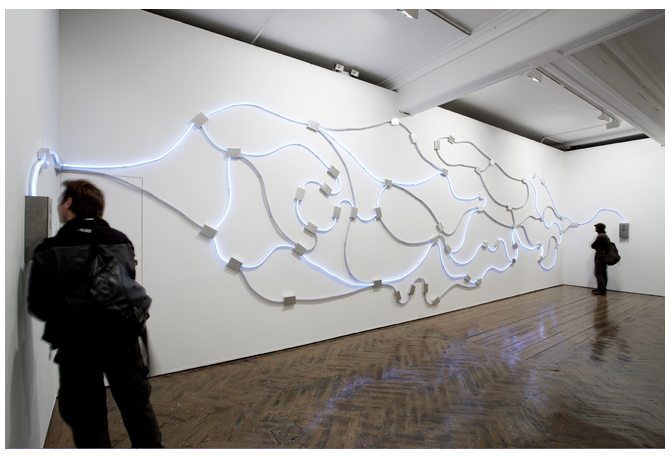Rafael Lozano-Hemmer at Haunch of Venison
The three floors at Haunch of Venison are filled with political and emotional, if not physical, volume. The seven works that make up Rafael Lozano-Hemmer’s exhibition use familiar technology to comment on the dissemination, (mis)interpretation and power of information. The viewer’s interaction with the pieces is a necessary element in all works (save one, Airport Cluster Plot [2001]).
The idea of surveillance is prevalent in the works Glories of Accounting (2005) and Reporters With Borders (2008). Both pieces employ surveillance mechanisms to track viewers movements. Glories of Accounting is a plasma screen that appears to be blank until activated by a viewer. Video of a hand appears that corresponds to the number of people in front of the work. The hands then turn according to the person’s movements. It is a humorous manifestation of a sinister practice. Reporters Without Borders is a more recent work that uses the same technology to more conceptual ends. Two panels of numerous talking heads are projected on to the wall. Each panel is assigned a classification that changes every few minutes. These borders, as Lozano-Hemmer identifies them, are: Light/Dark, Mexico/USA and Male/Female. The reporters’ visages are presented like an exponentially bigger, more professional, older and more diverse “Brady Bunch”. They remain silent and motionless until a person walks past the screen. As the person moves, the video turns on and the talking heads come to life. It is not possible to decipher what the newscasters are reporting on, as a cacophony of sound builds and then subsides with the viewers’ movements. It all seems all too familiar in the age of 24 -hour news channels and up-to-the-second reporting on blogs. The lyric from the Talking Heads song Psycho Killer comes to mind: “You’re talking a lot, but you’re not saying anything.” Lozano-Hemmer sets up the rules of how we are meant to gauge the news sources – gender, for example – which might reflect our own prejudices, but the rules are, in effect, meaningless as we cannot decipher the information being conveyed. How are we meant to digest and interpret that which we cannot understand?
Less Than Three and Pulse Tank (both 2008) poeticize human interaction. Less Than Three is a visual map using LED strips that light up as a voice travels from one intercom to another on opposite walls. It makes daily forms of communication visual, depicting the way information travels physical distance through imaginary space. This piece also illustrates the lengths to which people often have to go to communicate, whether between faraway places, hostile borders, or languages. Pulse Tank is made up of sensors that mimic heartbeat, sending pulses into a clear tank of water. A spotlight is projected on to it from an obtuse angle, causing the rippling water to be refracted and projected on to the floor and the wall. An immediate, if completely obvious, parallel is that it only takes one person to cause change; The recent American election and Obama-mania comes to mind. On the adjacent wall a monitor tracks heartbeats per minute, electrocardiogram and temperature of the participants. By reducing the work’s activators to the most basic life functions, gender, ethnicity and other polarizing indicators are neutralized. Lozano-Hemmer’s concern is the human element.
Rafael Lozano-Hemmer
Haunch of Venison
6 Haunch of Venison Yard, W1K 5ES
15 October – 29 November, 2008

leave a comment